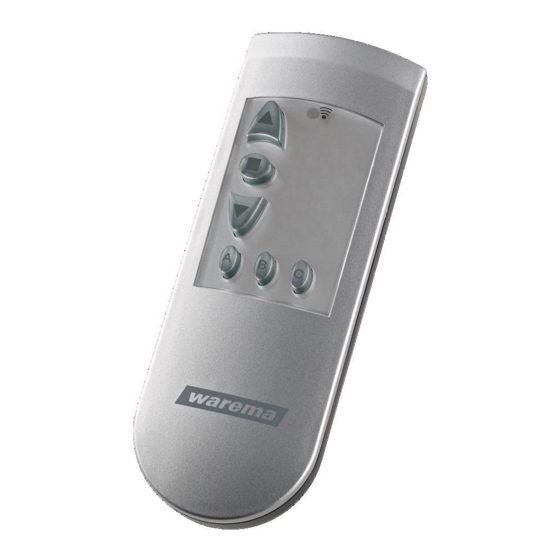
Advertisement
Quick Links
Operating and installation instructions
EWFS Plug receiver lighting
Keep for future use!
Valid from 01 September 2021
General information
Fig. 1
EWFS Plug receiver lighting
The EWFS Plug receiver lighting enables the simple and
cost-effective retrofitting of a wireless remote control for
lighting equipment. This requires minor electrical work.
The plug receiver can receive move commands from
EWFS-compatible transmitters, e.g.
EWFS Hand-held transmitters or EWFS Timer.
Intended use
The EWFS Plug receiver lighting is an electronic device
for controlling lighting equipment. Any use other than the
purpose described in these instructions requires approval
from the manufacturer.
Safety instructions
W
ARNING
The electrical installation (assembly)/
dismantling
electrician in accordance with VDE 0100 or
the legal requirements and standards of the
country in which the device is being installed.
The electrician must observe the installation
instructions included with the electrical
devices supplied.
W
ARNING
If hazard-free operation cannot be assumed,
the device may not be commissioned or must
be decommissioned. This assumption is
justified if
the housing or connecting lines
appear damaged
if the device is no longer working.
W
ARNING
Switch off the supply voltage of the EWFS
Plug receiver when you perform activities on
products connected to the plug receiver or on
connected lighting equipment. Danger due to
sudden movements of the equipment or electric
shock.
C
AUTION
Never press the buttons on your transmitter
randomly without a line of sight to the sun shading
system. Children must not play with this product –
keep remote controls and transmitters out of the
reach of children!
warema_2035334_alhb_en_v1•2021-09-01
must be performed by a certified
Due to both the legal regulations for radio systems and
structural factors, the operating range of radio remote
controls is limited. Sufficient radio reception must be
ensured when planning the project. This is especially the
case where the radio signal has to pass through walls
and ceilings. The control should not be installed in the
immediate vicinity of metal components (steel beams,
reinforced concrete, fire doors).
Therefore, check that the receiver is functioning
properly before the final installation.
Strong local transmitter systems (e.g. baby monitors or
neighbouring transmitters) can interfere with the reception.
Switch the mains supply back on. The device is then
ready for operation.
Function
To switch on the light: If you are using an 8-channel
hand-held transmitter, select the correct channel using the
channel buttons. If you are using a 1-channel hand-held
transmitter, this step is not necessary. Press the B button
briefly: the lamp switches on.
To switch off the light
If you are using an 8-channel
:
hand-held transmitter, select the correct channel using the
channel buttons. If you are using a 1-channel hand-held
transmitter, this step is not necessary. Press and hold the
B button until the lamp switches off.
Symbols used
When the receiver is delivered, it does not "know" any
transmitters initially and therefore must learn to respond to the
correct transmitters. We refer to this process as "learning-in".
Explanation of symbols:
Power-up: In order to learn, you must electri-
cally isolate a receiver or a group of receivers,
either at the in-line circuit breaker or at the as-
sociated plug-in connector, and then reconnect
it again after approx. 5 seconds. (Power-up pro-
cedure.) Always perform a power-up procedure
when you see the in-line circuit breaker symbol.
The receiver is now in learn mode for approx.
one minute. The learn button on the transmitter
must be pressed during this time interval or the
receiver will exit the learn mode. Push the learn
button on your transmitter whenever you see
the learn button symbol.
The lamp lights up: After the learn button on
the transmitter is activated, the connected lamp
is switched on. Release the button immediately.
If you are operating a fluorescent lamp, release
the button as soon as the lamp first goes on.
Learning in the master channel
You can learn either a 1-channel transmitter or one
channel of an 8-channel transmitter into a receiver. With
an 8-channel transmitter, you simply need to make sure
We reserve the right to make technical modifications
1
Advertisement

Summary of Contents for WAREMA EWFS
- Page 1 Fig. 1 EWFS Plug receiver lighting Strong local transmitter systems (e.g. baby monitors or The EWFS Plug receiver lighting enables the simple and neighbouring transmitters) can interfere with the reception. cost-effective retrofitting of a wireless remote control for Switch the mains supply back on. The device is then lighting equipment.
- Page 2 Ι channel 1, press the learn by means of "smart learning". For this purpose the button and hold it for at "EWFS Applications brochure" is available at: least 20 seconds; the lamp https://warema.com/media/866089.pdf. lights up twice and then stays off!
- Page 3 Special functions In this case, liability for secondary harm to persons or damage to property will also be excluded. The WAREMA EWFS also enables a wide range of special functions. Should you require further information, your Cleaning specialist dealer will be pleased to give you the application Clean the housing with a soft, damp cloth.
- Page 4 EXAMPLE When using a motor line type H05RR-F 4 G 0.75 connected downstream of the Earth conductor (yellow/green) EWFS Plug receiver, a 6 A on-site fuse Neutral conductor (blue) protection for the power supply must be provided. L phase (black)











Need help?
Do you have a question about the EWFS and is the answer not in the manual?
Questions and answers